

EPHEMERAL ACTS
The Carl & Marilynn Thoma Foundation
Foreward
Drawn from the Carl and Marilynn Thoma Foundation collection, the exhibition Ephemeral Acts explores the transient nature of time-based art, where time serves as both medium and composer. This selection of works is unified by a temporal state driven by various catalysts— from algorithms and choreography to dramaturgy, game engines, interactivity, and instruments. Each artwork unfolds a unique interpretation of a fleeting “real-time,” inviting viewers to consider the notion of ephemerality not only in art, but in life. All works exist fundamentally only in their moment of execution, resisting permanence yet leaving a lasting imprint through memory, legacy, and the creative act.
This exhibition also underscores the Foundation’s commitment to collecting, preserving, and sharing both the history and contemporary landscape of media art in depth. Each artist featured in Ephemeral Acts has more than one work in the collection’s holdings, demonstrating the Foundation’s priority to collect throughout an artist’s career. The work on view spans 1970-2025, highlighting the Foundation’s strategic dedication to a stewardship of the field from its inception to the present.
Kathleen Forde Director and Curator, Media Arts
This brochure was produced in association with the exhibition Ephemeral Acts.
October 2025 – May 2026 at Art Vault, Santa Fe, New Mexico
Thoma Foundation Team
Director and Curator, Media Arts
Kathleen Forde Collections Manager Meagan Robson
Santa Fe Art Spaces Director & Exhibitions Manager
Kathleen Richards
Acquisitions & Collections Coordinator
Rachel Lewis
Communications Coordinator Madison Spencer
Outreach Coordinator Katie Davis
Edited by Rachel Lewis and Madison
Spencer
Laurie Anderson
Born 1947 in Chicago, IL, lives in New York City
Laurie Anderson is an American avant-garde artist, musician, writer, and filmmaker whose work spans performance art, music, video, painting, and writing, often staged as multimedia presentations. Initially trained as a violinist and a sculptor, she focuses on using language, technology, and visual imagery. Her song “O Superman” reached number two in the UK singles chart in 1981, launching her commercial success and leading to her debut album, Big Science, in 1982. Recognized worldwide as a groundbreaking leader in the use of technology in the arts, she has created award-winning theatrical and documentary works and art installations, as well as invented pioneering acoustic and musical devices. Anderson’s work has been presented in major museums and performing arts centers throughout the United States and Europe.
From the Air, 2008
Clay figure and video projection with sound 5 minutes, 19 seconds
Located at the intersection of performance, visual arts, film, and beyond, Laurie Anderson’s unconstrained practice is perhaps most enduringly rooted in her
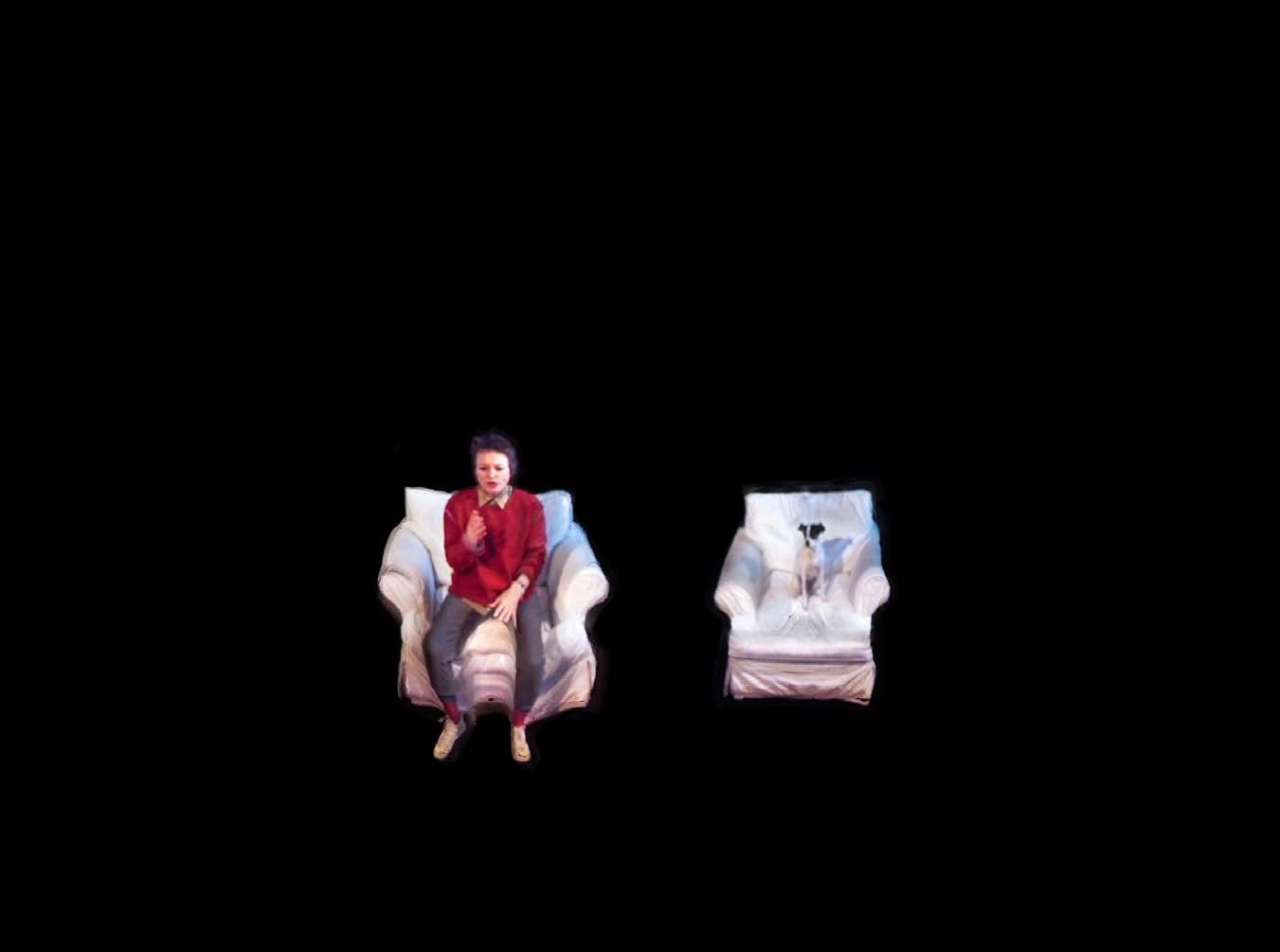
miniature Anderson, with her cherished dog Lolabelle at her side, weaves an analogy
Handphone
Table, 1978-2025
Handcrafted wooden table and sound system
Laurie Anderson’s Handphone Table transforms a seemingly simple, five-foot-long wooden table into a human-activated conduit for binaural sound.
Anderson was inspired to create her first “singing table” in 1978 after an accidental discovery. One day while working, she rested her head in her hands with her elbows on a table. She soon realized that this gesture allowed her to hear the vibrations of a typewriter travel through the wood and her arms to her inner ear via bone conduction, leading to the basic conceit of Handphone Table. This version of Handphone Table, created specifically for the Thoma Foundation collection in 2025, conceals an audio system that relies on the viewer’s body to channel subtle vibrations, vocal tones, and delicate instrumental music that otherwise remain inaudible without this physical engagement.

Dara Birnbaum
Born 1946 in New York City, died 2025
Dara Birnbaum was a pioneer of installation and video art and a key figure in the feminist art movement of the 1970s. She created her first video artwork in 1978 after studying architecture and painting, then video and electronic editing. She is known for analyzing gender representation and bias in TV and film. The foundational techniques of her work involve the repetition of images and disruptions with text and music. Some of her famous artworks heavily sample footage from Laverne & Shirley (1978) and Hollywood Squares (1979). By the 1990s, Birnbaum had become regarded as a pioneering contributor to the Pictures Generation, an influential art movement based in New York City.
Six Movements: Video Works from 1975, 1975
Chaired Anxieties: Abandoned, Mirroring, Control Piece
Single-channel videos (black and white, silent)
3 from a set of 6 videos Varying durations
Six Movements: Video Works from 1975 is a limited edition boxed set representing Birnbaum’s earliest video experiments. In the three works on view in this exhibition (Control Piece, Mirroring, and Chaired Anxieties: Abandoned, pictured in order), the artist explores various psychological states through her personal, unfiltered performances for the camera. In so doing, she not only suggests a feminist subtext that continued to be present throughout the most significant works of her career but also emphasizes the camera’s relationship to the viewer and the subject to the performer. The latter strategy, when read through the lens of our contemporary, social media addicted culture, takes on an entirely new meaning and resonance for our times. These earliest works reveal a link to the performance-video practices of the generation of artists who immediately preceded her, such as Vito Acconci, Joan Jonas, and Bruce Nauman.


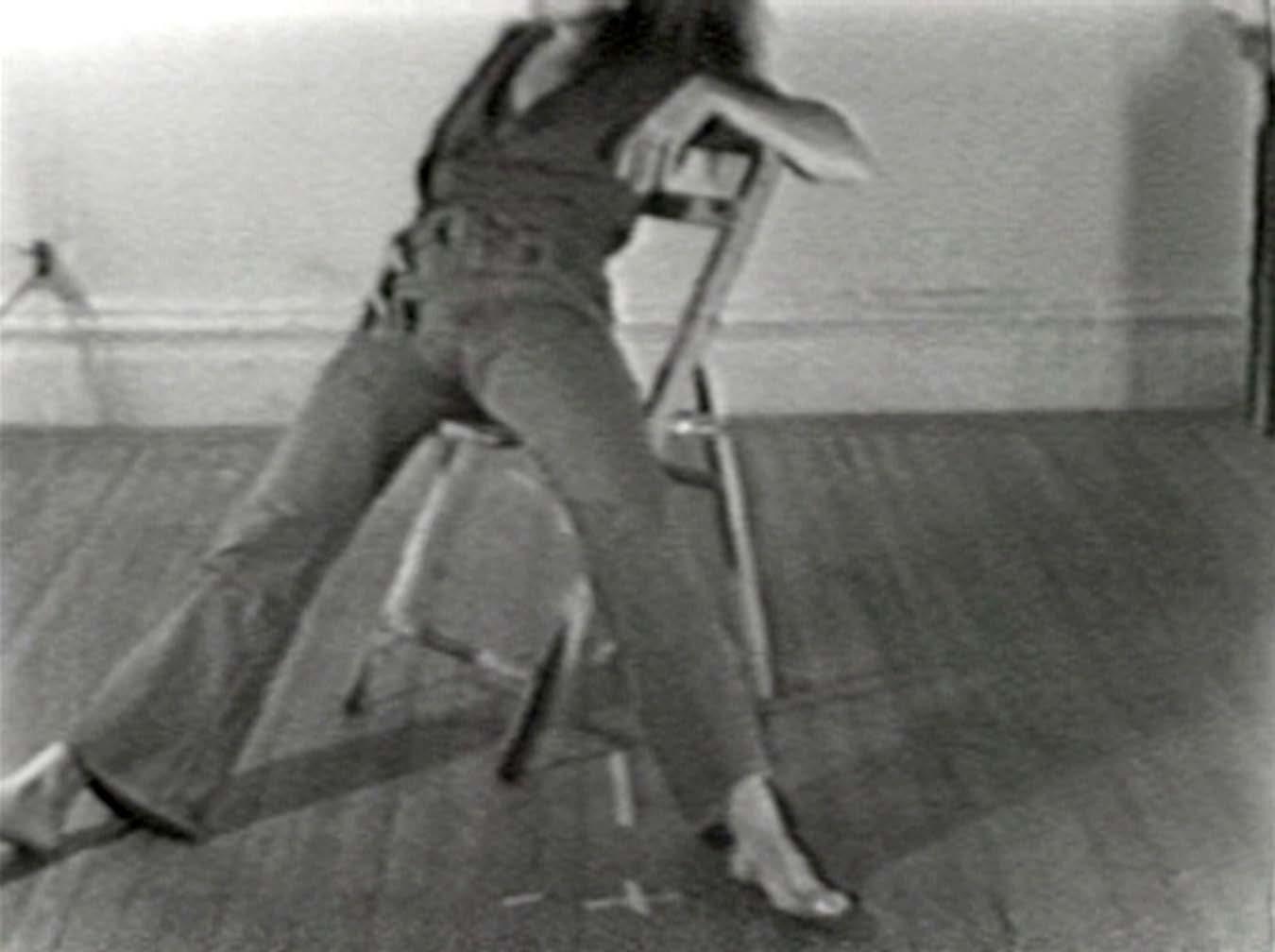
Nick Cave
Born 1959 in Fulton, MO, lives in Chicago, IL
Nick Cave is an American sculptor, dancer, performance artist, fashion designer, and professor. He received a Bachelor of Fine Arts from the Kansas City Art Institute, where he studied fiber arts, and studied dance through the Alvin Ailey American Dance Theater company. He earned his master’s degree from Cranbrook Academy of Art in Michigan and is currently the director of the graduate fashion program at the Art Institute of Chicago. Cave is best known for his Soundsuits, wearable assemblage sculptures that blend performance, fabric, and found objects to form a commentary on race, identity, and gender. Cave often performs in the Soundsuits himself, dancing either for the public or for the camera, activating their cathartic, sublime potential as performative, living sculptures. In his work, he draws from his childhood experiences, growing up in a low socio-economic status, which led to him learning how to sew and repair his siblings’ hand-me-down clothing, and influences from African art traditions, ceremonial dress, couture, and textiles. In all of Cave’s work, there is a pervasive and empathetic exploration of various forms of social injustice with a nuanced undertone of transformation, healing, and ultimately transcendence.
Gestalt, 2012
Single-channel digital video (color, sound), projector 16 minutes
Gestalt presents the experience of Cave’s legendary Soundsuits being performed. The Soundsuits themselves are his creative response to the vulnerability he experienced as a black man during 1991, when LA police violently beat Rodney King, an unarmed black man, after a high-speed chase. Cave thinks of the Soundsuits as akin to armor that empowers the wearer by exquisitely concealing their body while simultaneously making them extraordinarily visible. He considers the video Gestalt as an extension of the Soundsuit performances, which are an extension of the Soundsuits themselves.

Soundsuit, 2014
Fabric, sequins, beads, mannequin, metal, armature
Cave’s Soundsuit represents a multicultural history of geometric art. The costume’s design references international abstract art traditions, including Islamic motifs, African kente cloth patterns, Creole Mardi Gras masks, and the painted Modernist grids of Mondrian. The Soundsuit is also Cave’s response to racial profiling in the U.S. Like a suit of armor, the disguise is meant to empower the beleaguered body beneath, making its wearer highly visible but also hidden.
This Soundsuit is notable for featuring completely different recto and verso designs. It debuted within an exhibit of traditional African masks at the St. Louis Art Museum in 2014. Sometimes the artist wears his Soundsuit during performances, in which the costume generates sound based on the different materials used that comprise it.

Analivia Cordeiro
Born 1954 in São Paulo, Brazil, lives in São Paulo
Since the early 1970s, Analivia Cordeiro has been developing a continuous and intensive body of transdisciplinary work that explores the relationships between audio-visual art and media, body and movement, in space and time. She is considered a pioneer in video art and computer-based video dance, and she is one of the first artists in the world to program computer-based dance choreographies explicitly created for the video camera. Equally significant has been her creation of a visual aesthetic that revolutionized the traditional languages of ballet and dance on film. What modern sculpture accomplished—the turn from the body to space— Analivia Cordeiro accomplished for dance.
0=45
Version I, 1974-75
Single-channel video (black and white, sound), 3 minutes, 23 seconds
In 1974, Analivia Cordeiro created 0=45, an early video in the experimental dance film tradition. The artist herself performs a choreography programmed in the Fortran IV language, which was then processed in a mainframe computer at the Computer Center of the University of Campinas, Brazil. Fortran created the notation that Cordeiro then used to interpret and influence a choreography, essentially programmed by a computer. The bold, precise, repetitive style of the set design, dancer’s movements, and costumes all reference the aesthetic of Concrete Art, while the dance itself reflects a sense of sculpture in motion. This work is presented alongside two signed prints.
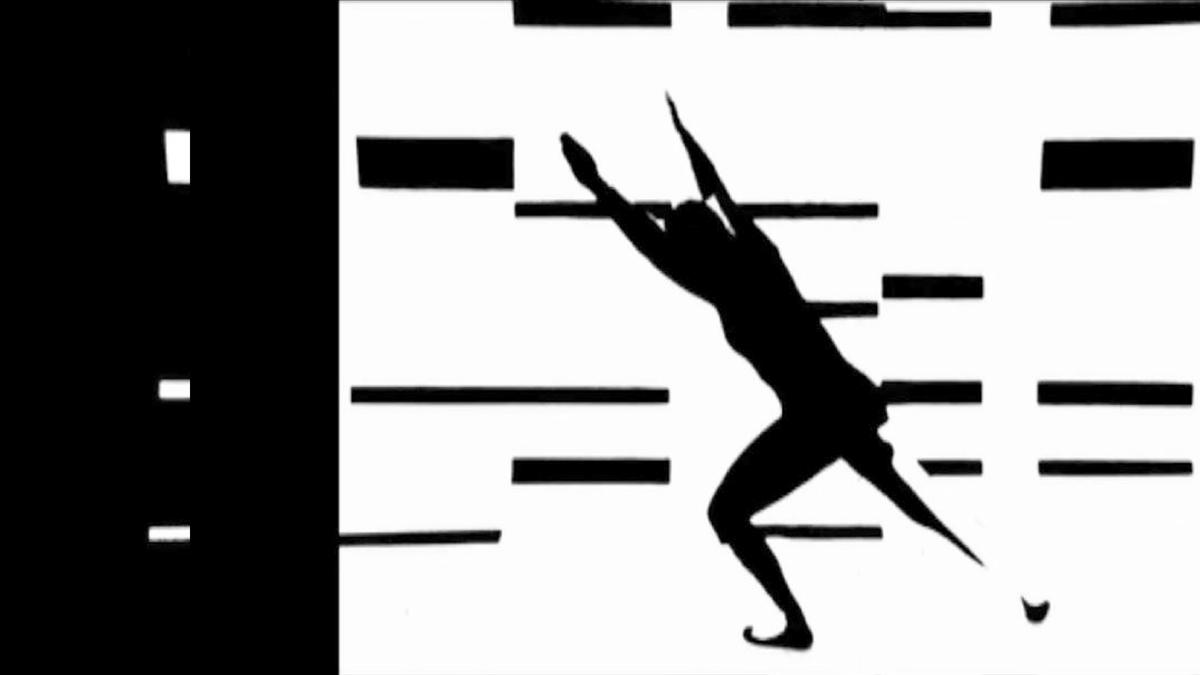
0=45 Dance Notation, 1974/2025
Digital print on archival paper, signed by artist 8.27 x 11.69 in
Cordeiro’s dance notations were generated by a Fortran VI output. The artist would then translate the output into notation for the dancer to interpret as choreography.
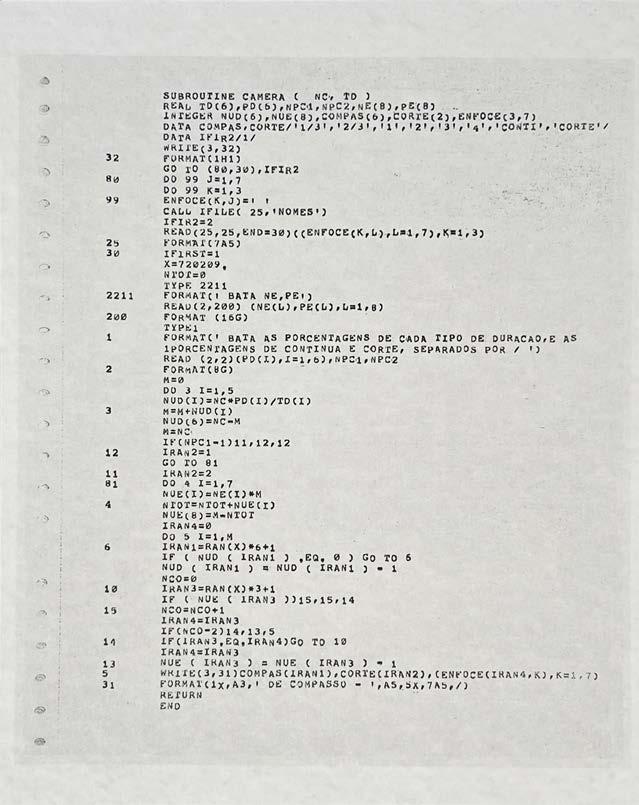
0=45 Body Position, 1974/2025
Digital print on archival paper, signed by artist 11.69 x 8.27 in
This algorithm was written in the computer programming language Fortran IV to specifically define the dancer’s choreography in the recording of the work 0=45.

R. Luke DuBois
Born 1975 in Morristown, NJ, lives in New York City
R. Luke DuBois is an American composer, performer, conceptual artist, and programmer. Since 2005, he has produced software-generated artworks that analyze cultural patterns using large data sets of public information. DuBois is a notable electronic musician and composer with a doctorate in music composition. His algorithmic music has appeared on twenty-five albums since 1997. He has also taught at many universities, including Columbia, Princeton, and the School of Visual Arts. He is currently a Full Professor and the co-director of Integrated Digital Media at New York University’s Tandon School of Engineering, where his conceptual art and instruction at NYU concentrate on the visual transcription of data. His art spans performance, video, installation, and generative, algorithmic-based works that explore information theory, temporality, and gaze.
Academy, 2006
Single-channel video (color, sound) 76 minutes
For Academy, DuBois compiled every winning film in the Academy Awards’ “Best Picture” category from 1927 through 2006 into a time-lapsed animation in which each film is condensed into a one-minute abstract sequence, distilling cinematic artistry from narrative arcs into visual patterns. Essentially, this generative, codedriven process is the conceptual art of our digitally overstimulated times—art that not only affects our perception but challenges our standard modes of processing information.
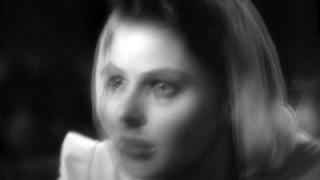
(Pop) Icon: Britney, 2010
Single-channel HD video (color, sound), custom wood frame, stereo speakers 60 minutes
(Pop) Icon: Britney combines thousands of photographs of Britney Spears into a constantly morphing portrait, always centered on the pop star’s eyes. DuBois creatively and strategically explores how Spears, like many digital celebrities, built her fame by promoting manipulated images of her face and body for public enjoyment. Despite being one of the world’s most photographed celebrities, Spears risks becoming dehumanized by her own cult of personality, as suggested by this elusive portrait. To create this artwork, DuBois fed 2,000 images of Spears into a face-recognition algorithm, a type of surveillance technology used by governments to identify known terrorists among crowds. DuBois was excited to test this new technology against the notoriously altered images of Spears, questioning if he could track her real identity with the help of his custom software.
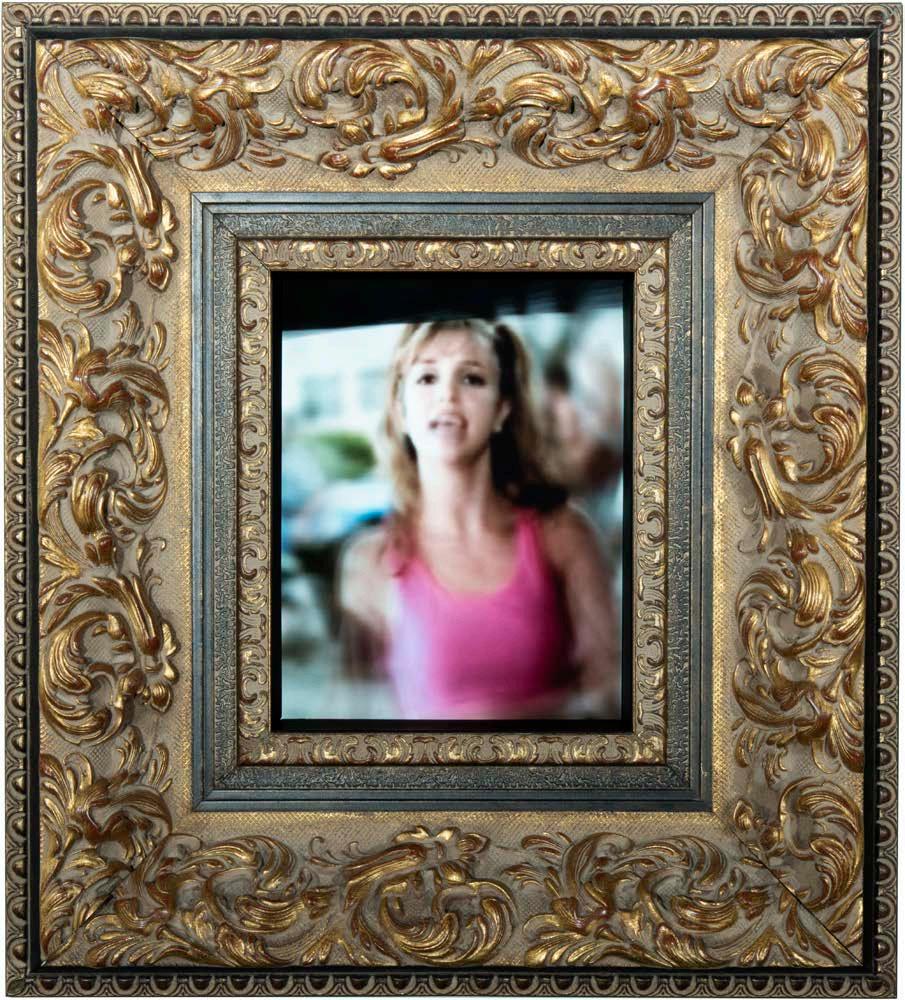
John Gerrard
Born 1974 in North Tipperary, Ireland, lives in Dublin, Ireland
John Gerrard is an Irish digital simulation and sculpture artist. He blends portrait, landscape, and installation with the post-cinematic medium of 3D simulation. His computer-generated simulations exist outside ‘time-based media,’ using real-time computer graphics to create virtual and alternate worlds. While studying for his BFA at Oxford University, he experimented with 3D scanning as sculptural photography. Gerrard is a graduate of the School of the Art Institute of Chicago and Trinity College in Dublin. In 2002, he was awarded the Pépinières Residency at Ars Electronica, Linz, where he developed his first works in 3D real-time computer graphics. His work explores contemporary power structures, human expansion, and pivotal moments in the Industrial Age, merging portrait, landscape, and history painting with the Unigine 3D engine as a medium. Each work operates from an algorithm and set of conditions, generating imagery in the virtual world. His eerily hyperreal, melancholic realms have a physical presence when installed as large-scale projections or ‘artboxes’ designed in collaboration with an industrial design firm in Vienna.
Ghost Feed, 2025
Generative custom software animation, monitor Infinite (live generation)
In Ghost Feed, a white-cheeked spider monkey sits nearly motionless in a virtual forest, immobilized by a smartphone screen that loops an endless feed of its own reflection. As digital day fades into night in this game-engine-driven simulation, flames—drawn from real footage of wildfires ravaging the Amazon and California— slowly consume the surrounding landscape. Meanwhile, John Gerrard presents the monkey as remaining transfixed by the phone, unaware or even indifferent to the unfolding scene around it. In so doing, Gerrard captures the paralyzing impression of a global sense of inertia amid unraveling ecosystems and eroding geopolitical agency.
Ghost Feed is representative of the Thoma Foundation’s commitment to supporting artistic production via the commissioning of a limited number of new work(s) by artists who are collected by the Foundation in depth. This support often comes prior to creation, when the work is in the stage of an artist’s sketch, rendering, or idea. Ghost Feed was originally commissioned for its debut at the Folkestone Triennial 2025 in the UK by the Thoma Foundation and the Triennial, with additional support from The Arts Council of Ireland.

Ragnar Kjartansson
Born 1976 in Reykjavík, Iceland, lives in Reykjavík
Ragnar Kjartansson creates video installations, performances, drawings, and paintings that blend historical and cultural references. He blurs the distinctions between mediums, likening his film to paintings and performances to sculpture. He explores beauty and its banality through durational, repetitive performance, with underlying connections of pathos and irony influenced by classical theater’s comedy and tragedy. Major solo shows include exhibitions at the Kunstmuseum Stuttgart, The Metropolitan Museum of Art, Reykjavík Art Museum, Musée d’art contemporain de Montréal, Palais de Tokyo in Paris, the New Museum of Contemporary Art, and the Fondazione Sandretto Re Rebaudengo, Turin. Kjartansson represented Iceland at the 53rd Venice Biennale in 2009 and participated in The Encyclopedic Palace at the 55th in 2013.
Scenes from Western Culture, 2015
Seven single-channel HD videos (color, sound), seven monitors
Scenes from Western Culture is Ragnar Kjartansson’s multi-channel video installation documenting mundane moments from affluent lifestyles. The series, intentionally hung “salon style,” includes seven of the nine independent durational performances and scenes from the series: Guitar Lesson, Rich German Children, Dinner, Dog and Clock, The Boat, Burning House, and Gentleman. Together, the vignettes are a sympathetic satire of “the good life,” displayed on wall-mounted TV monitors in a gallery like an exhibition of Old Master paintings.



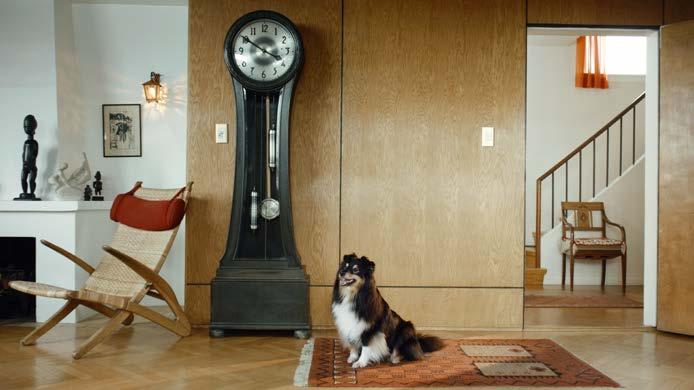


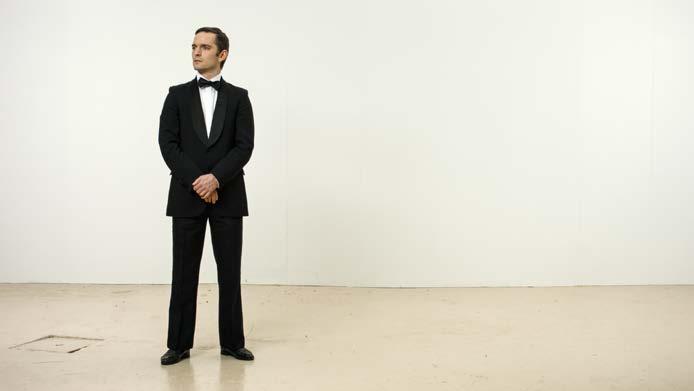
Casey Reas
Born 1972 in Troy, OH, lives in Los Angeles, CA
Casey Reas is an artist, programmer, and professor. His work encompasses a range of mediums, including works on paper, large-scale installations, software, solo projects, and collaborations with architects and musicians. He uses the systematic rules of coding to generate digitally abstract art in his software works, as seen in his META series. In collaboration with Ben Fry, a data visualization designer, he co-founded Processing in 2001. Processing is an open-source programming language and environment for the visual arts, widely used by artists to code visual animations and interactive artwork. Reas has a bachelor’s degree from the College of Design, Architecture, Art, and Planning at the University of Cincinnati, a master’s degree from MIT in Media Arts and Sciences, and is a professor at the University of California, Los Angeles.
Today’s Ideology (28 August 2016), 2016
Generative custom software animation (color, silent), computer, monitor
Today’s Ideology is an algorithmic artwork that takes all of the editorial photos from a single day of The New York Times as the basis for a digital paintbrush texture that slowly stretches the news images across the screen in eternally changing layers, never to repeat their composition. Reas downloaded every photograph published in The New York Times on Sunday, August 28, 2016, into a database and randomly sequenced them into this endless-duration animation. By blending all of the day’s images into an algorithmically generated cascading composition, the artist intends to upend the editorial hierarchy of headline news stories. Some topics are identifiable, while others seem lost to time.

METAVASARELY, 2024
Custom software (color, silent), computer
METAVASARELY is part of a series of artworks by Casey Reas, which includes METASOTO, METAMOLNAR, and CENTURY. This series reimagines 20th-century Op Art and algorithmic works by Victor Vasarely, Jesús Rafael Soto, and Vera Molnár as 21st-century generative code systems. In the late 1960s, Op Art artist Victor Vasarely proposed a project for LACMA’s Art and Technology Program, but it was never realized due to its prohibitive cost. The proposal described a machine with a grid of lights designed to generate millions of unique configurations inspired by his paintings. In 2024, Casey Reas responded to Vasarely’s unfulfilled concept with two related artworks, including METAVASARELY, that simulate Vasarely’s proposed machine as a software application that automatically generates endless abstract arrangements that take Vasarely’s palette, color gradients, and optical vibrations as its cue. Commissioned by and specifically for the Thoma Foundation’s collection in 2024, this version of METAVASARELY is presented on a square screen as a tribute to the Vasarely paintings that inspired it. METAVASARELY was created with the help of Wylie Kasai, studio assistant. This work utilizes Reas’ programming language Processing. An online version of this work, also titled “METAVASARELY,” was commissioned by LACMA in conjunction with the exhibition Coded: Art Enters the Computer Age, 1952–1982, organized by LACMA’s Art + Technology Lab.

Steina
Born 1940 in Reykjavík, Iceland, lives in Santa Fe, NM Steina has spent over three decades expanding the boundaries of video technology, electronic imaging, and new media art. Initially trained as a classical violinist at the Prague Conservatoire and then the Iceland Symphony Orchestra, her interests in experimental music and engineering led her to visual art in New York during the late 1960s and 1970s. Her career includes filmmaking, live performances, kinetic sculptures, single-channel videos, and multi-channel installations. Using video, she explores the potential for the generation of sound from images and images from sound. She has also taught at the Center for Media Study of the State University of New York, the Akademie für Angewandte Kunst in Vienna, and the Staatliche Hochschule für Gestaltung Karlsruhe.
Violin
Power, 1970-78
Single-channel digital video (black and white, sound), projector 10 minutes, 4 seconds
In Steina’s Violin Power, the classically trained Vasulka performs for the camera with a violin connected to image processing devices. The sound and vibrations of the violin affect the image we see, thus creating abstractions of the footage of the artist herself in this video that Steina refers to as a “demo tape on how to play video on the violin.” This work is indicative of the impact that the introduction of image-processing machines had on the art world in the 1970s. It pushed forward the integration of performance and installation and set the stage for musicians and performers to “play” the moving image—in this case, video—like music.
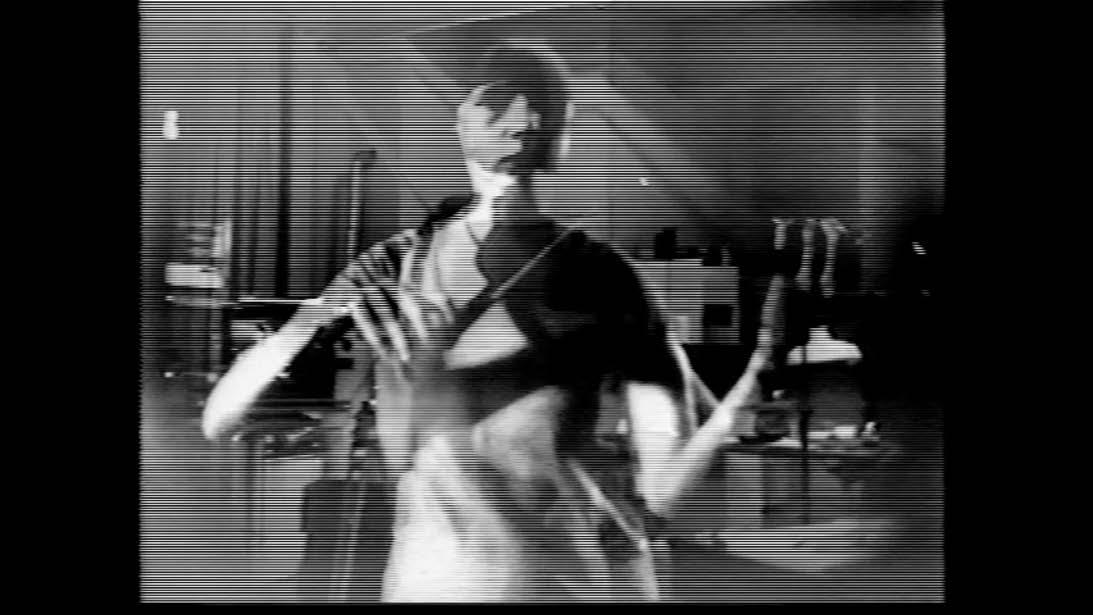
Woody and Steina Vasulka
Woody born 1937 in Brno, Czechoslovakia, died 2019 in Santa Fe, NM Steina born 1940 in Reykjavík, Iceland, lives in Santa Fe, NM
Woody and Steina were early pioneers of video art. Since the 1960s, they have produced experimental work using images, videotapes, computer graphics, and television program video effects. The Vasulkas developed tools to manipulate electronic signals into cutting-edge audio and visual artworks. Woody first trained as an engineer, then moved to Prague to study television and film production at the Academy of Performing Arts, where he met Steina. They began collaborating and married in 1964. After moving to New York, the couple founded the influential non-profit art space The Kitchen, a media theater in the kitchen of the Mercer Arts Center in the Grand Central Hotel that became an inclusive and welcoming space for music, performance, and media artists.
Noisefields
, 1974
Single-channel digital video (color, sound), monitor 12 minutes, 5 seconds
Noisefields is a pioneering attempt to depict the materiality of an electronic signal. Throughout the video, a circular field of signal noise, or “snow,” flashes in a rhythmic pattern on the screen. The “noise,” a random display pattern created by electromagnetic interference, is created by sources that range from nearby electronic devices to cosmic microwave radiation produced during the Big Bang. The visual field of “snow” is accompanied by a fluctuating static sound modulated by the energy content of the video signal, extending the audio-visual rendering of the invisible electronic signal.
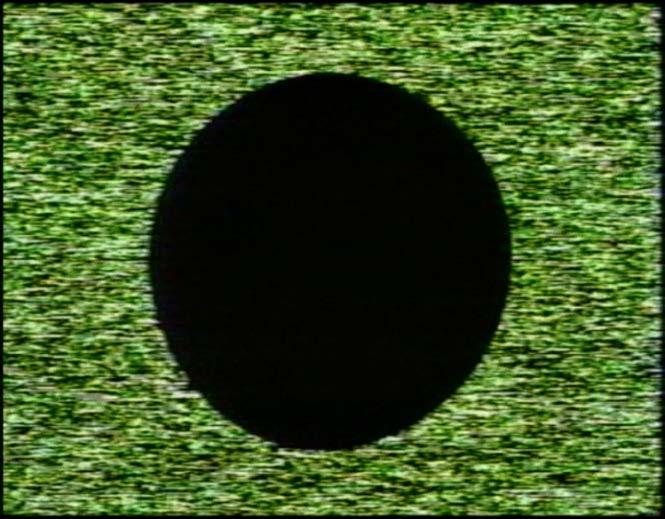
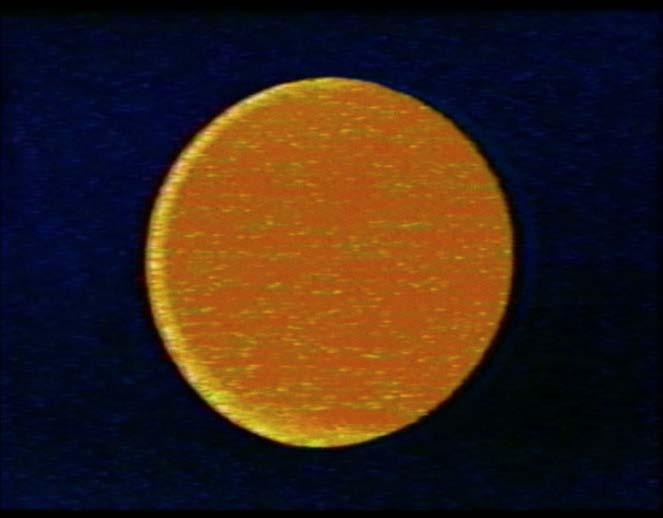
Bill Viola
Born 1951 in New York City, died 2024 in Long Beach, CA
Bill Viola is an internationally recognized art-technology innovator and key figure in the video art movement since the 1970s. His work includes videotapes, architectural video installations, sound environments, and electronic music performances, focusing on the emotional depths of the body, face, and human spirit. His installations explore universal human experiences of birth, death, and consciousness. In 1978, he married Kira Perov, the cultural arts director at La Trobe University, and they began a lifelong collaboration working and traveling together. Viola received a BFA in Experimental Studios from Syracuse University and numerous awards, including a Visual Artist Fellowship from the National Endowment for the Arts.
The Raft, 2004
Color high-definition video projection on wall, 5.1 channels of surround sound
Site-specific installation
Projected image size: 14 ft x 7 ft
Room dimensions: 16 ft 6 in x 18 ft 8 in x 21 ft 4 in 10 minutes, 33 seconds
Performers: Sheryl Arenson, Robin Bonaccorsi, Rocky Capella, Cathy Chang, Liisa Cohen, Tad Coughenour, James Ford, Michael Irby, Simon Karimian, John Kim, Tanya Little, Mike Martinez, Petro Martirosian, Jeff Mosley, Gladys Peters, Maria Victoria, Kaye Wade, Kim Weild, Ellis Williams
The Raft depicts a life-sized scale of a group of nineteen men and women from a variety of ethnic and economic backgrounds, casually standing together. Suddenly, they are struck by strong blasts of water that rush in from out of frame. Some are immediately knocked over, and others brace themselves against the unprovoked deluge. People in the group cling to each other for survival, as the simple act of remaining upright becomes an intense physical struggle. Then, as suddenly as it arrived, the water stops, leaving behind a band of suffering, bewildered, and battered individuals. The group slowly recovers as some regain their senses, others weep, while the few with any strength assist those who have fallen. The viewer experiences this event in an immersive setting, standing in a darkened room surrounded by the roaring sounds of the water. Captured in slow-motion, The Raft arouses a visceral experience of calamity and shared humanity, provoking a consideration of the range of responses to crisis and the resilience found in community.
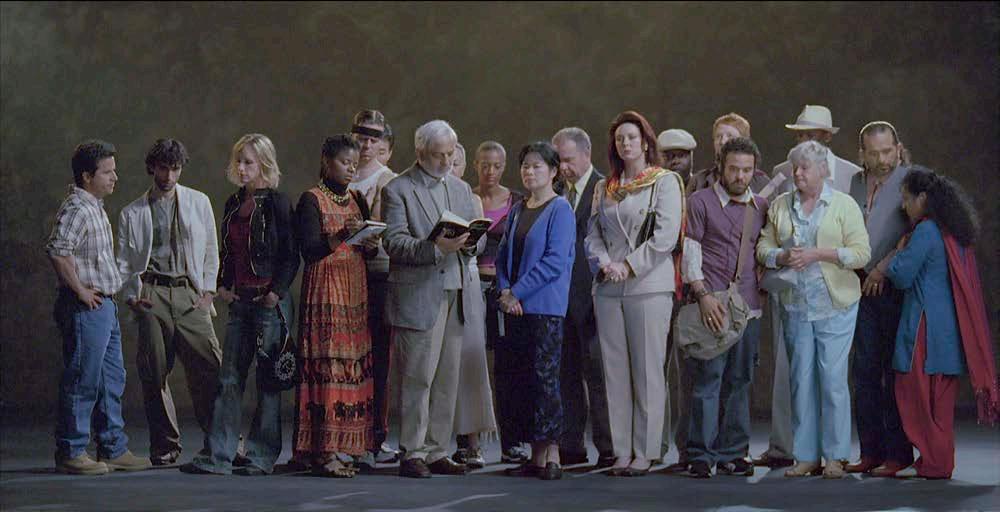

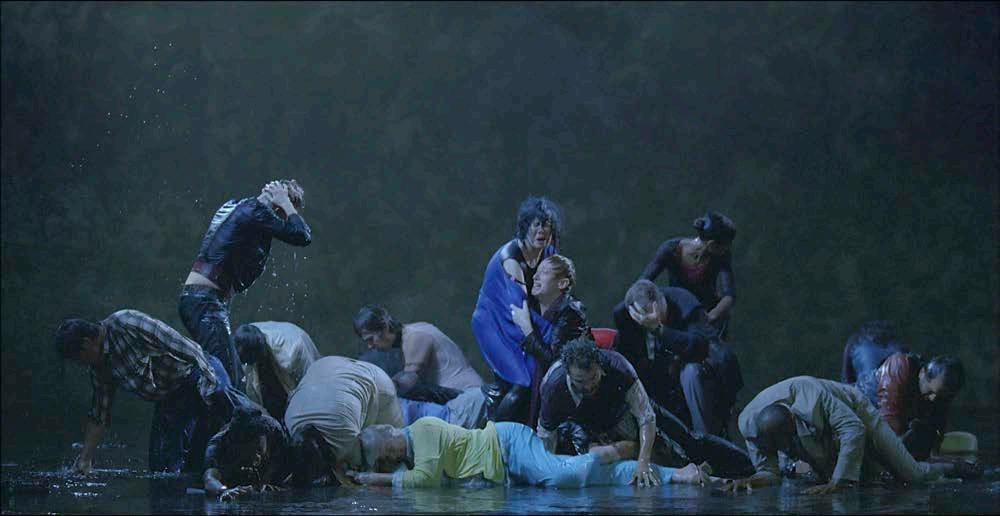
Catherine’s Room, 2001
Five-channel SD video (color, silent) 18 minutes, 39 seconds
Bill Viola’s Catherine’s Room captures the sacred value of ordinary routines, inspired by the life of Saint Catherine of Siena (1347–1380), who had visions of stigmata on her hands and whose graceful writings describe ecstatic devotion. Filmed in real time, the five videos portray Catherine’s daily activities, including meditation, prayer, writing, and sleeping in quiet isolation. The seasons pass through her window, symbolizing her life stages spent in a single room. Viola’s scene asks viewers to identify how spirituality or introspection manifests below the surface of what we can observe.


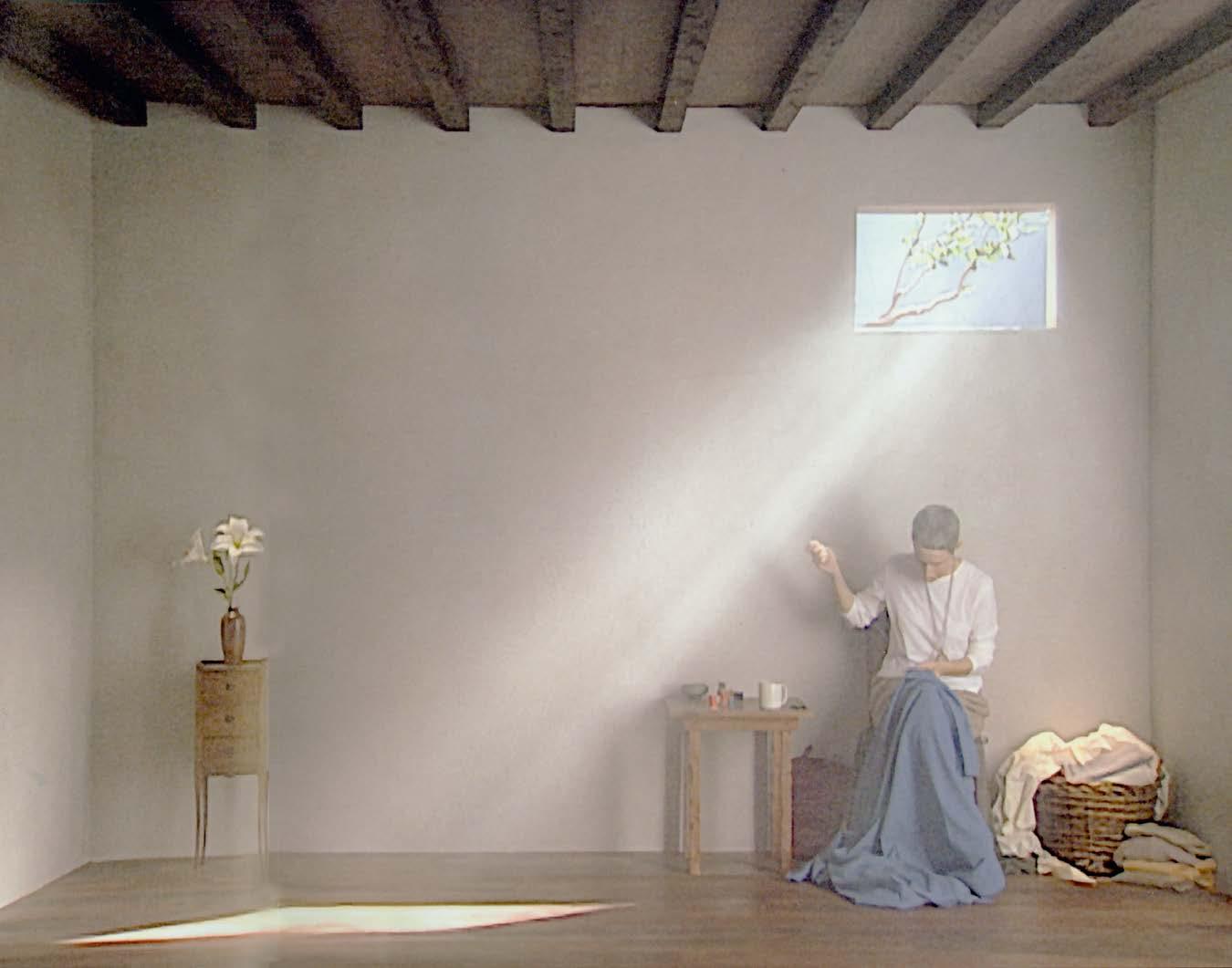

3
4
5
Laurie Anderson, From the Air, 2008. Clay figure and video projection with sound, 5 minutes, 19 seconds. Image courtesy of the artist.
Laurie Anderson, Handphone Table, 1978-2025. Handcrafted wooden table and sound system. Image courtesy of the artist and the Hirshorn Museum and Sculpture Garden, Washington D.C.
Dara Birnbaum, Six Movements: Video Works from 1975 (Chaired Anxieties: Abandoned, Mirroring, Control Piece), 1975. Three single-channel videos (black and white, silent). Images courtesy of the artist.
Nick Cave, Gestalt, 2012. Single-channel digital video (color, sound), projector, 16 minutes. Image courtesy of the artist and Jack Shainman Gallery, New York.
Nick Cave, Soundsuit, 2014. Fabric, sequins, beads, mannequin, metal armature. Photo by James Prinz Photography, © Nick Cave. Courtesy of the artist and Jack Shainman Gallery, New York.
6
Analivia Cordeiro, 0=45 Version I, 1974-75. Single-channel video (black and white, sound), 3 minutes, 23 seconds. Image courtesy of the artist. 7
Analivia Cordeiro, 0=45 Body Position, 1974/2025. Digital print on archival paper, signed by artist, 11.69 x 8.27 inches. Image courtesy of the artist.
8
9
10
11
Analivia Cordeiro, 0=45 Dance Notation, 1974/2025. Digital print on archival paper, signed by artist, 8.27 x 11.69 inches. Image courtesy of the artist.
R. Luke DuBois, (Pop) Icon: Britney, 2010. Single-channel HD video (color, sound), custom wood frame, stereo speakers, 60 minutes. Photo by Jamie Stukenberg, © R. Luke DuBois. Courtesy of the artist and the Carl and Marilynn Thoma Foundation.
R. Luke DuBois, Academy, 2006. Single-channel video (color, sound), 76 minutes. Image courtesy of the artist.
John Gerrard, Ghost Feed, 2025. Generative custom software animation, monitor, infinite (live generation). Image courtesy of the artist.
13
14
15
16
17
18
Ragnar Kjartansson, Scenes from Western Culture, 2015. Seven singlechannel HD videos (color, sound), monitors. Images courtesy of the artist and i8 Gallery, Reykjavík.
Casey Reas, Today’s Ideology (28 August 2016), 2016. Generative custom software animation (color, silent), computer, monitor. Image courtesy of the artist and bitforms gallery, New York.
Casey Reas, METAVASARELY, 2024. Custom software (color, silent), computer. Image courtesy of the artist.
Steina, Violin Power, 1970-78. Single-channel digital video (black and white, sound), projector, 10 minutes 4 seconds. Image courtesy of the artist.
Woody and Steina Vasulka, Noisefields, 1974. Single-channel digital video (color, sound), monitor, 12 minutes 5 seconds. Images courtesy of the artists.
Bill Viola, The Raft, 2004. Color high-definition video projection on wall; 5.1 channels of surround sound. Site specific installation: 7 ft x 14 ft projection. 10 minutes, 33 seconds. Image courtesy of the artist.
Bill Viola, Catherine’s Room, 2001. Five-channel SD video (color, silent), 18 minutes, 39 seconds. Photos by Jamie Stukenberg, © Bill Viola. Courtesy of the artist and the Carl and Marilynn Thoma Foundation.
About
Based in Dallas, Texas, the Carl & Marilynn Thoma Foundation collection includes over 2,000 works and spans four broad fields: Art of the Spanish Americas, Digital & Media Art, Japanese Bamboo, and Post-War Painting & Sculpture. In addition to exhibiting our collection at our two free gallery spaces, Art Vault in Santa Fe, New Mexico, and our Cedar Springs Headquarters in Dallas, the Foundation has loaned over 2,200 artworks to more than 250 exhibitions worldwide. We make a concerted effort to share our collection with the public, conserve the works in it, and provide documentation and research that puts each piece into a more widely understood context. We award individual grants and fellowships to support original scholarship across our collection areas, supporting research, symposia, and equity in the arts. Our grants for nonprofit organizations help fund innovative exhibitions, academic programs, and collection-related publications.
In 2024, the Foundation launched the Thoma Scholars Program to help broaden access to higher education for promising rural students in the rural American Southwest. Working with our university partners, the Thoma Scholars Program is a comprehensive scholarship that helps talented students graduate with as close to zero debt as possible. Beyond financial support, the Thoma Scholars Program gives high-achieving students a path to promising futures through mentorship, educational support, and leadership training.
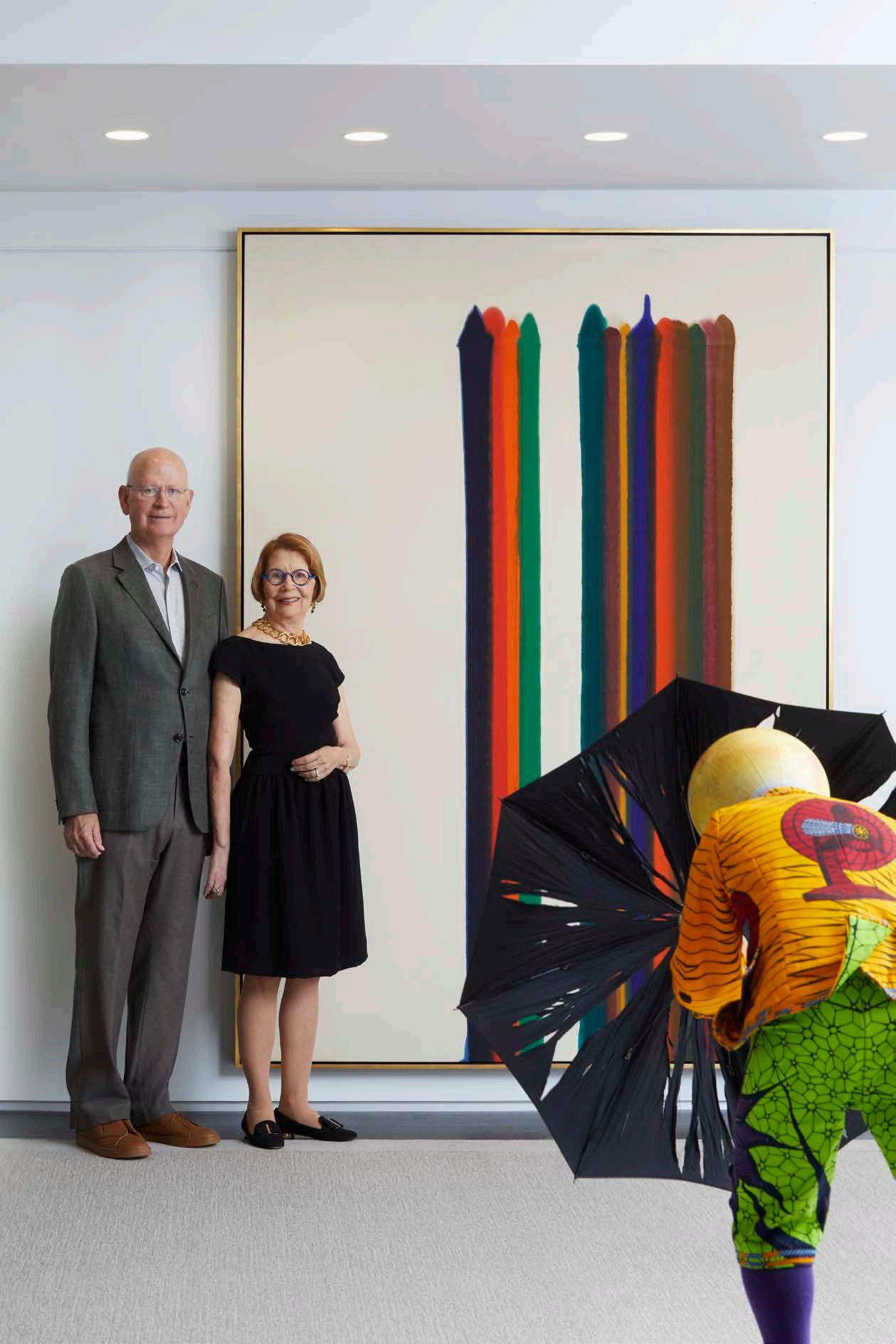
Cover Image
The Raft, May 2004, Bill Viola
Video/sound installation
Color high-definition video projection on wall; 5.1 channels of surround sound
Site-specific installation, projected image size: 14 ft x 7 ft 10 minutes, 33 seconds

